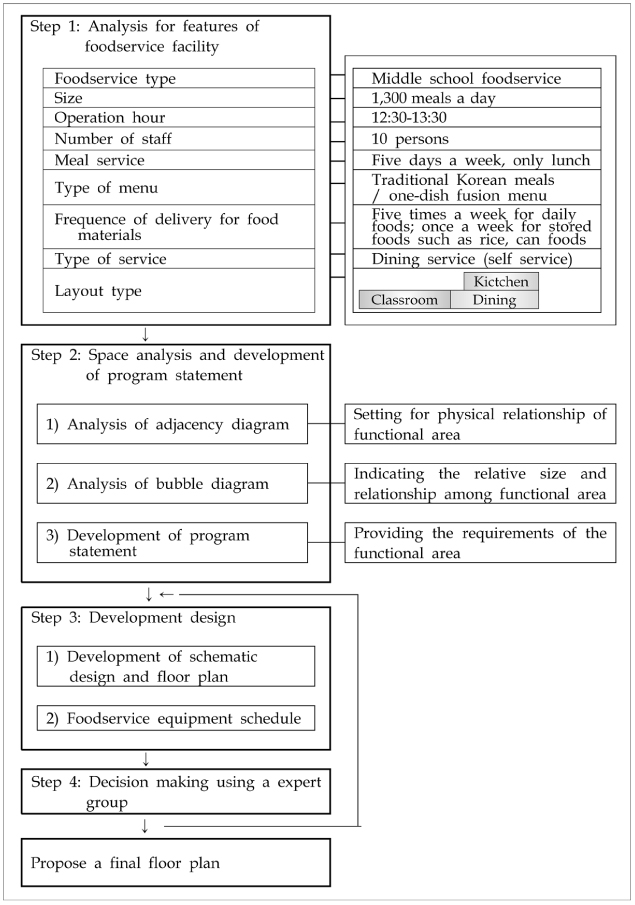References
1. Chang HJ, Kwak TK, Demicco JF, Knabel JS. A case study for developing a model for a HACCP-compliant kitchen in the foodservice industry. Journal of Asian Regional Association for Home Economics 2005. 12(3)179–189.
2. Chang HJ, Son HJ, Choi GG. Current status of functional area's space and suggestion of their equipment requirements for school foodservices in Gyeonggi Province. Korean J Food Cookery Sci 2009. 25(4)474–487.
3. Choi GG. Development of the facility model on the HACCP guidelines and DRY-kitchen facility standards for improvement of sanitation standards of middle and high schools' foodservice 2005. Yonsei University, The Graduate School of Human and Environmental Sciences; 5–35.
MS thesis.
4. Daegu Metropolitan Office of Education. Manual of standardized facility layout for efficient driving of school foodservice facility modernization 2007. Daegu Metropolitan Office of Education; 9–39.
5. Daegu Metropolitan Office of Education. Guideline for school foodservcie facility 2007. Daejeon Metropolitan Office of Education; 1–4.
6. Gangwon-do Office of Education. General management guideline for school foodservice: Specific guideline of school foodservcie and staffing foodservcie worker 2007. Gangwon-do Office of Education; 1–3.
7. Gyeonggi-do Office of Education. Geneal management guideline for school foodservice. Gyeonggi-do Office of Education 2009. cited 2009 Nov 10. Available from
http://www.goe.go.kr.
8. Gangwon-do Office of Education. Guideline for school foodservcie facility and equipment 2008. Gyeongsangbuk-do Office of Education; 2–28.
9. Jeong SY, Lee HR, Oh DS. A study on the planning of school catering facilities using the HACCP system. J Archit Inst Korea 2002. 18(1)3–10.
10. Kim TH, Chang HJ, Yoon JH. Design and layout of foodservice facilities 2004. Seoul: Sigma Press Co.; 27–138.
11. Kwak TK, Lyu ES, Lee HS, Lyu K, Choi SK, Hong WS, Jang MR, Shin ES, Moon HK, Chang HJ, Park SJ, Choi EH, Lee KE. Institutional foodservice operation 2008. Seoul: Shinkwang Pub.; 287–298.
12. Lee TH, Lee JR, Lee SH. A study on improvement of the cafeteria planning in educational facility case study on elementary school in Daegu city. J Korean Hous Assoc 2004. 15(6)99–106.
13. Ministry of Education Science and Technology. Case study of facility improvement for efficient driving of school foodservice facility modernization plans 2006. Ministry of Education Science and Technology; 2–59.
14. Ministry of Education Science and Technology. School Lunch Act Rules 2009. cited 2009 Nov 30. Available from
http://likms.assembly.go.kr.
15. Ministry of Education Science and Technology. Sanitation management guidelines for school foodservice operation: Desirable facility design and layout for foodservice 2010. 3rd edth ed. Ministry of Education Science and Technology; 11–24.
16. Oh DS. Study on standard kitchen designing plan for school cafeteria. Chungnam University, 2000 Ministry of Education Policy development research report 2000. 84–171.
17. Oh DS, Lee HR. School buildings: a study on planning guidance and models for school catering facilities(I). Korean Inst Educ Facil 2001a. 8(2)84–92.
18. Oh DS, Lee HR. School buildings: a study on planning guidance and models for school catering facilities(II). Korean Inst Educ Facil 2001b. 8(3)91–96.
19. Oh DS, Lee HR. School buildings: a study on planning guidance and models for school catering facilities(III). Korean Inst Educ Facil 2001c. 8(4)78–85.
20. Park YJ, Kwak TK, Kang YS, Chung HK. Assessment of the child care center' foodservice facility and development of the kitchen facility modal based on the general sanitation standards and guidelines. J Korean Diet Assoc 2003. 9(3)219–232.
22. Seoul School Health Promotion Center. Menual for school foodservice facility improvement 2008. Seoul School Health Promotion Center; 23–54.
23. Yoon MY, Lee IS. Analysis on facilities & basic equipment of school foodservice safety in Pohang area. J Korean Diet Assoc 2006. 12(3)264–276.







